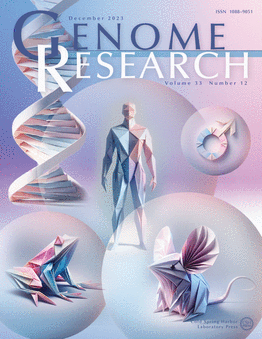基于纳米孔的共识测序能够实现准确的多模态肿瘤无细胞DNA分析
IF 6.2
2区 生物学
Q1 BIOCHEMISTRY & MOLECULAR BIOLOGY
引用次数: 0
摘要
浅层全基因组无细胞DNA(cfDNA)测序可提供可靠的拷贝数变异(CNA)和片段组图谱,因此在无创癌症监测方面大有可为。然而,由于测序误差,单核苷酸变异(SNV)在测序深度较低的情况下更难识别。在这里,我们介绍了纳米孔滚动圈扩增(RCA)增强共识测序(NanoRCS),它利用基于全基因组长线程纳米孔测序的 RCA 和共识调用,通过 SNV、CNA 和片段组学同时进行多模态肿瘤分型估计。NanoRCS 的功效在 18 个癌症患者样本和 7 个健康对照样本上进行了测试,证明它能可靠地检测出低至 0.24% 的肿瘤成分。体外实验证实,SNV 测量对于检测低于 3% 的肿瘤片段至关重要。NanoRCS 为成本效益型快速处理提供了机会,这非常符合临床需求,尤其是在快速准确的癌症监测对个性化治疗策略至关重要的情况下。本文章由计算机程序翻译,如有差异,请以英文原文为准。
Nanopore-based consensus sequencing enables accurate multimodal tumor cell-free DNA profiling
Shallow genome-wide cell-free DNA (cfDNA) sequencing holds great promise for non-invasive cancer monitoring by providing reliable copy number alteration (CNA) and fragmentomic profiles. Single nucleotide variations (SNVs) are, however, much harder to identify with low sequencing depth due to sequencing errors. Here we present Nanopore Rolling Circle Amplification (RCA)-enhanced Consensus Sequencing (NanoRCS), which leverages RCA and consensus calling based on genome-wide long-read nanopore sequencing to enable simultaneous multimodal tumor fraction estimation through SNVs, CNAs, and fragmentomics. Efficacy of NanoRCS is tested on 18 cancer patient samples and seven healthy controls, demonstrating its ability to reliably detect tumor fractions as low as 0.24%. In vitro experiments confirm that SNV measurements are essential for detecting tumor fractions below 3%. NanoRCS provides the opportunity for cost-effective and rapid processing, which aligns well with clinical needs, particularly in settings where quick and accurate cancer monitoring is essential for personalized treatment strategies.
求助全文
通过发布文献求助,成功后即可免费获取论文全文。
去求助
来源期刊

Genome research
生物-生化与分子生物学
CiteScore
12.40
自引率
1.40%
发文量
140
审稿时长
6 months
期刊介绍:
Launched in 1995, Genome Research is an international, continuously published, peer-reviewed journal that focuses on research that provides novel insights into the genome biology of all organisms, including advances in genomic medicine.
Among the topics considered by the journal are genome structure and function, comparative genomics, molecular evolution, genome-scale quantitative and population genetics, proteomics, epigenomics, and systems biology. The journal also features exciting gene discoveries and reports of cutting-edge computational biology and high-throughput methodologies.
New data in these areas are published as research papers, or methods and resource reports that provide novel information on technologies or tools that will be of interest to a broad readership. Complete data sets are presented electronically on the journal''s web site where appropriate. The journal also provides Reviews, Perspectives, and Insight/Outlook articles, which present commentary on the latest advances published both here and elsewhere, placing such progress in its broader biological context.
 求助内容:
求助内容: 应助结果提醒方式:
应助结果提醒方式:


